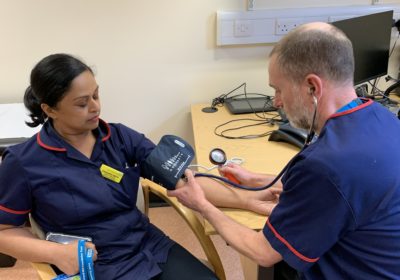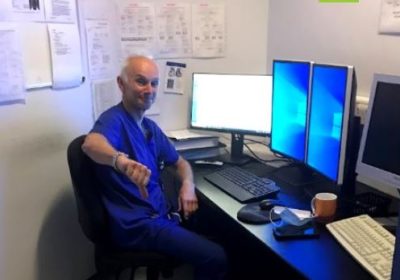Healthwatch England has welcomed the announcement today of a new workforce plan for the NHS.
Record numbers of doctors, nurses, dentists and other healthcare staff will be trained in England as part of the first ever Long Term Workforce Plan published by the NHS and backed by the Government today.
Coming ahead of the health service’s 75th anniversary, the NHS Long Term Workforce Plan sets out how the NHS will address existing vacancies and meet the challenges of a growing and ageing population by recruiting and retaining hundreds of thousands more staff over 15 years and working in new ways.
The NHS plan, described as a once in a generation opportunity to put staffing on a sustainable footing and improve patient care, focuses on retaining existing talent and making the best use of new technology alongside the biggest recruitment drive in health service history to address the gap.
It was commissioned and accepted by the Government, which has backed the plan with over £2.4bn to fund additional education and training places over five years on top of existing funding commitments.
For the first time the Plan sets out long term workforce projections. Staffing shortfalls have been an issue since the foundation of the NHS and vacancies now stand at 112,000.
The growing and ageing population, coupled with new treatments and therapies, means that without action, the gap could grow up to 360,000 by 2037.
The NHS plan aims to reduce reliance on expensive agency spend that could cut the bill for taxpayers by around £10bn between 2030/31 and 2036/37.
Since its foundation the NHS has relied on the skills and dedication of staff who have come here from around the world and there will always be a place for them.
However, with demand for healthcare staff rising around the world the Long Term Workforce Plan sets out the path to:
- double medical school training places to 15,000 by 2031, with more places in areas with the greatest shortages
- increase the number of GP training places by 50% to 6,000 by 2031
- almost double the number of adult nurse training places by 2031, with 24,000 more nurse and midwife training places a year by 2031.
Taken with retention measures, the NHS Plan could mean the health service has at least an extra 60,000 doctors, 170,000 more nurses and 71,000 more allied health professionals in place by 2036/37.
Advances in technology and treatments mean that staff numbers and roles will change over time so the NHS will refresh the Long Term Workforce Plan at least every two years to help meet future requirements.
This plan will kickstart efforts to address current shortages with an immediate boost in training numbers. By 2028, government investment will mean half a million trainees will have begun clinical training, on a path to increase by over 60% by 2031.
Over the next five years alone medical places will increase by almost a third for medical places, nursing degrees will increase by more than a third and GP training places will jump by a quarter.
To ensure the NHS can draw on the widest pool of talent, more training places will be offered through degree apprenticeships so staff can “earn while they learn” – gaining a full degree while ensuring they meet the high clinical standards required by the relevant professional regulators, including GMC and NMC.
One in six (16%) of all training for clinical staff will be offered through apprenticeships by 2028 – including more than 850 medical students.
The growing number of nursing degrees will be accompanied by a 40% rise in nursing associate training places over five years, with increases in other associate roles which will support and free up other clinical colleagues.
A renewed focus on retention, with better opportunities for career development, improved flexible working options, alongside government reforms to the pension scheme, should mean that up to 130,000 staff stay working in NHS settings longer.
Investment in new technology will also help to close the gap and free up staff to focus on using their expertise to help patients.
The NHS will continue to harness advances in AI, with an expert group being set up to identify advanced technology that can be best used across the country.
Other measures to boost the NHS workforce include:
- Trainees will be on wards and in practices sooner, with plans to work with the GMC and medical schools to consult on the introduction of four-year medical degrees and medical internships, allowing students to start work six months earlier.
- More student nurses will be able to take up jobs as soon as they graduate in May, rather than waiting until September, with more reaching the frontline and treating patients more quickly.
- New medical schools could also open up in areas of the country where there is the greatest staffing shortfall, with similar plans for postgraduate medical training places.
- Train around 150 additional advanced paramedics annually, including to support the delivery of same day emergency care.
- Expand training places for clinical psychology and child and adolescent psychotherapy, on a path to increasing by more than a quarter to over 1,300 by 2031.

Amanda Pritchard, NHS chief executive, said: “This is a truly historic day for the NHS in England – for 75 years, the extraordinary dedication, skill and compassion of NHS staff has been the backbone of the health service – and the publication of our first-ever NHS Long Term Workforce Plan now gives us a once in a generation opportunity to put staffing on sustainable footing for the years to come.
“As we look to adapt to new and rising demand for health services globally, this long term blueprint is the first step in a major and much-needed expansion of our workforce to ensure we have the staff we need to deliver for patients.
“We will take practical and sustained action to retain existing talent, we will recruit and train hundreds of thousands more people and continue to accelerate the adoption of the latest technology to give our amazing workforce the very best tools to provide high-quality care to millions of people across the country each day.
“Crucially, this plan will also ensure there is an NHS career choice that works for everyone now and in the future, so if you are interested in working for the NHS, or have loved ones who might be, please do find out more – it is a decision I have never regretted.”
Commenting on the document, Matthew Taylor, chief executive of the NHS Confederation, said: “This will be a day that many NHS leaders could be forgiven for thinking would never come, but it offers hope to the almost 1.4m staff working in the NHS who have been holding out for years for such a comprehensive plan to boost recruitment and retention.
“Based on everything we have seen and heard about the plan so far, we think it will go a long way to addressing the workforce challenges we are facing. But we look forward to seeing the more detailed modelling, planning assumptions and productivity increases envisaged in it to understand the full implications.”
Sir Julian Hartley, chief executive at NHS Providers, added: “This plan must be a pivotal moment for the health service. Staff lie at the heart of everything the NHS does, but there is no denying that many are exhausted and burnt out under the weight of mounting pressure.
“National backing to expand recruitment and training, and retain and support staff, is therefore critical to ensure trusts can provide the best care for patients – now and in the future.
“The plan’s ambitions are promising but the details will be crucial. We need to see how it will be funded and implemented, and there must be regular reviews and updates. The commitment to refresh it every two years is a good start.”
Louise Ansari, chief executive at Healthwatch England, said: “All too often, we hear stories of people whose care is delayed, cancelled, or postponed, putting many in danger, due to severe staffing gaps across health and care services. The much-needed funding and resource for the NHS workforce will be essential to underpin NHS recovery in the longer term.
“It is also positive to see the plan invest in technology to support innovative training methods and freeing up capacity for clinical staff.”
Rachel Power, chief executive of the Patients Association, added: “The publication of today’s workforce strategy will be an important milestone for both staff and patients, and in reinforcing public faith in the NHS.
“We have been clear for a long time that the enormous challenges the NHS faces cannot be met without sufficient numbers of staff, and we hope that this plan will address the long-term workforce issues relating to retention and recruitment.”
But Eddie Crouch, chair of the British Dental Association, said: “This workforce plan is government’s latest attempt to fill a leaky bucket. Failed contracts and underfunding are fuelling an exodus from this service. There’s little point training more dentists who don’t want to work in the NHS.”
Professor Kamila Hawthorne, chair of the Royal College of GPs, said: “The NHS relies on its people and has been in dire need of a long-term workforce plan to ensure it not only exists but is thriving in years to come. We look forward to seeing the full plan, but what we’re hearing are some encouraging proposals.”
Sources: NHS England/Healthwatch England/PA News Wire






